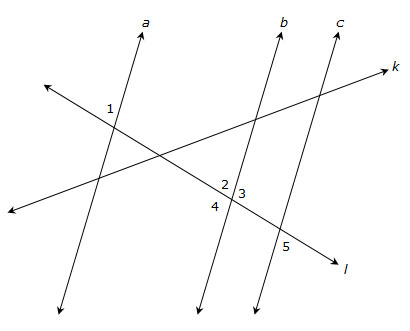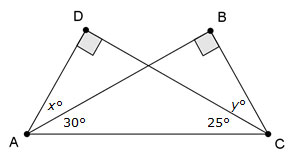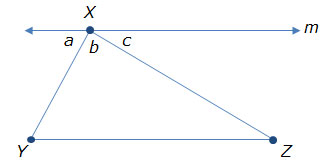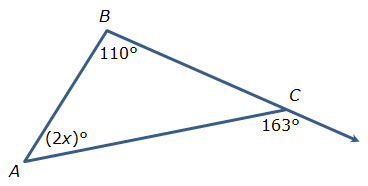
In the diagram below, lines a, b, and c are all parallel. Lines k and l intersect the lines as shown.

Which of the following equations must be true?
A. m∠1 + m∠2 = 180
Incorrect. ∠1 and ∠2 are corresponding angles with parallel lines a and b. Corresponding angles are congruent, not supplementary.
B. m∠4 + m∠5 = 180
Correct!
C. m∠2 + m∠3 + m∠4 = 180
Incorrect. ∠2 and ∠3 form a straight line and so do ∠2 and ∠4. Two angles that form a straight line are supplementary, so the sum of all three angles cannot be 180.
D. m∠3 + m∠4 = 180
Incorrect. This equation will only be true if ∠3 and ∠4 are right angles, and you do not know if b⊥I.
Right triangle ABC and right triangle ACD overlap as shown below.

Which of the following equations could be used to determine the value of x?
A. x + 30 + 25 = 180
Incorrect. Triangle ADC is a right triangle, so the sum of all three interior angles, including the right angle, is 180.
B. x + 25 + 90 = 180
Incorrect. m∠DAC = (x + 30)°, not just x°.
C. (x + 30) + 25 + 90 = 180
Correct!
D. 2(x + 30) + 90 = 180
Incorrect. ∠DAC and ∠DCA are not congruent angles, so they do not have the same measures.
In the figure below, line m is parallel to YZ.

Which of the following statements is true?
A. Angle a and angle Y are alternate interior angles, as are angle c and angle Z.
Correct!
B. Angle a and angle Y are corresponding angles, as are angle c and angle Z.
Incorrect. XY and XZ are transversals between parallel lines m and YZ. These two pairs of angles are alternate interior angles, not corresponding angles.
C. Angle a and angle c are vertical angles, so they have the same measure.
Incorrect. Vertical angles have the same measure, but angle a and angle c are not vertical angles.
D. Angles a, b, and c are complementary angles because they form a straight line.
Incorrect. Angles a, b, and c are supplementary angles, not complementary angles, since they form a straight line.
In the figure below, determine the value of x.

A. 136.5
Incorrect. The measure of an exterior angle is equal to the sum of the measures of the two remote interior angles. Use this relationship to set up and solve an equation.
B. 53
Incorrect. This number is the value of 2x. To solve the equation for x, you need to also divide both sides of the equation by 2.
C. 46.5
Incorrect. The measure of an exterior angle is equal to the sum of the measures of the two remote interior angles. Use this relationship to set up and solve an equation.
D. 26.5
Correct!
In the figure below,  AB ∥
AB ∥  JK.
JK.

Which of the following statements best describes why Δ ABC is similar to Δ KJC?
A. m∠A = m∠K because corresponding angles have equal measures. m∠B = m∠J because corresponding angles have equal measures. Since two pairs of angles have equal measures, the angle-angle criterion of similar triangles is met, and the two triangles are similar.
Incorrect. The two given pairs of angles are alternate interior angles, not corresponding angles.
B. m∠A = m∠K because alternate interior angles have equal measures. m∠B = m∠J because alternate interior angles have equal measures. Since two pairs of angles have equal measures, the angle-angle criterion of similar triangles is met, and the two triangles are similar.
Correct!
C. m∠A = m∠K because alternate interior angles have equal measures. m∠B = m∠J because alternate interior angles have equal measures. AB = 1 2 JK, so the two triangles are similar.
Incorrect. You do not know that AB = 1 2 JK from the information given in the figure. The two pairs of angles do have equal measures, so the angle-angle criterion of similar triangles is met.
D. m∠A = m∠K because corresponding angles have equal measures. m∠B = m∠J because alternate corresponding angles have equal measures. AB = 1 2 JK, so the two triangles are similar.
Incorrect. You do not know that AB = 1 2 JK the information given in the figure. Also, the given angle pairs are alternate interior angles, not corresponding angles. The two pairs of angles do have equal measures, so the angle-angle criterion of similar triangles is met.